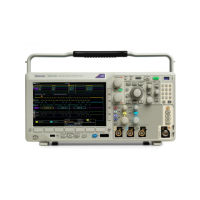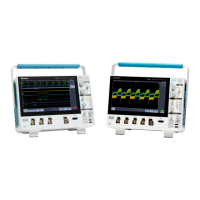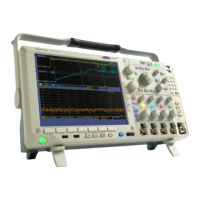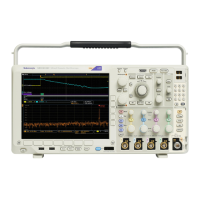Command Groups
attenuation, fi
ltering and down-conversion, depending on the parameters set by
the user (frequency, span, reference level, and so forth.)
For the MDO400
0/B/C series models, the acquisition system uses one of three
frequency bands to acquire RF data depending on where the center frequency and
span are set. The bands are: 50 kHz to 3.75 GHz, 2.75 GHz to 4.5 GHz, and
3.5 GHz to 6.0 GHz.
For the MDO3000 series models, there is one frequency band (up to 3 GHz
depending on the model and installed options).
Specifying the Reference
Level and Resolution
Bandwidt
h (RBW) Settings
For the MDO4000/B/C series models, the reference level is adjustable from
–140 dBm to +30 dBm. For the MDO3000 series models, the reference level
is adjustable from –140 dBm to +20 dBm. For all series, attenuation is set
automatically with the reference level. The RBW setting is adjustable downto
20 Hz. By
default, the RBW tracks span in automatic mode in a 1000:1 ratio;
this ratio is adjustable.
Detection Types
All MDO instruments calculate Fast Fourier Transform calculations (FFTs) with a
1,000 t
o ~2,000,000 point output, depending on the acquisition settings. It then
reduces that FFT output into a 1,000 pixel-wide display (for the MDO4000/B/C)
or 750 pixel-wide display (for the MDO3000). This means that approximately
1 to 2,000 FFT points get compressed into each pixel column. There are four
choices as to how this compression is done: +peak, sample, average, and -peak.
TriggeringUsingRFPower
Level as a Source
You can use the RF power level as a source for triggering with the MDO4000/B/C
models (but not the MDO3000 models). The MDO4000/B/C triggered acquisition
system is fully integrated with both the frequency and time domains. This means
that a single event can trigger all of the analog, digital and RF acquisitions,
re
gardless of whether that event came from an analog, digital or RF input. The
RF power level has been distilled through special processing and may be used
as a trigger. RF Power may be used as a source for Edge triggering. With an
MDO4TRIG application module installed, the RF Power level can also be used as
a source for pulse width, timeout, runt, logic and sequence triggering. (For more
information, see Triggering on the RF input. (See page 2-76, Trigger Command
Group.)
Spectrogram Display
(MDO4000/B, MDO4000C with option SA3 or SA6, and MDO3000). The
spectrogram is a graph of frequency domain traces over time. It provides an
intuitive display that is useful for monitoring slowly changing RF events,and
for identifying low amplitude signals too subtle for the eye to catch in a regular
spectrum display. The x-axis shows frequency, and the y-axis shows time.
Amplitude is represented by the color of the trace. Cold colors (blue, green)
indicate low amplitude, and hot colors (red, yellow) indicate high amplitude.
MDO4000/B/C, MSO/DPO4000B and MDO3000 Series Oscilloscopes Programmer Manual 2-49

